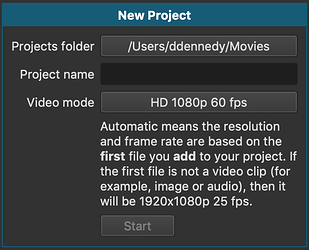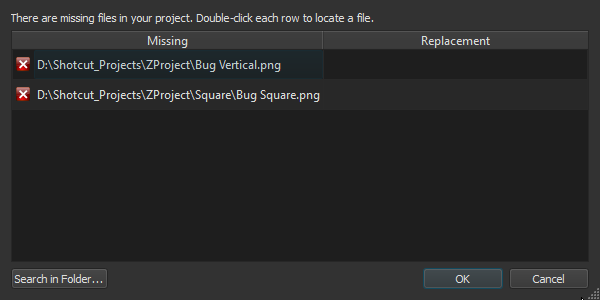Introduction
Shotcut does not provide very much in the way of project management at this time. Rather, you are required to manage many aspects of this. There are a few things you should know:
- Shotcut saves to a project file in a text format called MLT XML. (Technical detail on that format can be found here.)
- The project file does not contain any of your media. Rather, it only links to your media files by file system path and name.
- There are 3 different kinds of projects:
- Clip
If you put anything in Playlist or Timeline and you open a media file (or generator), then you can save it as a clip-only project along with trimming information as well as filters and their keyframes. - Playlist
If you add some things to the Playlist but not the Timeline, then you have saved a playlist-only project. - Timeline
This is what most people use, but keep in mind it is not necessary to use the timeline. Any of the above can be exported as a final audio/video file!
- Clip
Project Folder
Shotcut supports the concept of a project folder, which is optional. A project folder is when you create a file system folder for your project and you put project file in there along with whatever companion files get created as well as media files if you choose.
When Shotcut first starts (or after you choose File > New or File > Close), this view appears in the area for the Source player:
You use this to create a project folder. When you use it, Shotcut creates a folder on the file system with the name in Project name within Projects folder. Then, it saves an empty project with the name in Project name followed by .mlt. Thereafter, companion files that Shotcut creates are saved automatically into the project folder instead of requiring you to name them:
- Stabilize video filter
- Text: HTML video filter
- Properties > Reverse
- Text to Speech
- Record Audio
- Screen Snapshot
- Screen Recording (depending on operating system, see Screen Recording Generator)
- Image/Video from HTML
- New > Animation
- Mask: Draw video filter
- Settings > Proxy > Storage > Use Project Folder
We encourage you to store all or most of the media files that you use in the project in the project folder. However, Shotcut does not provide a way to automatically copy or move the files into there automatically at this time. Use your operating system’s file manager for that. If you move the files after they were added to the project, the next time you open the project it will show a missing files dialog where you can re-link them to the project folder.
You can also store multiple .mlt (MLT XML) files in your project folder. You could be nestinge/embedding child MLT XML files within the parent project file, or you could use this to have multiple timelines in a project (each timeline is its own MLT XML file). If you have Settings Backup turned on, the backup files are saved in this project file too.
Use the Files panel (menu item View > Files) ![]() folder path drop-down and choose Current Project to view its contents. Or use from the menu File > Show Project in Folder to open your operating system’s file manager to the project folder.
folder path drop-down and choose Current Project to view its contents. Or use from the menu File > Show Project in Folder to open your operating system’s file manager to the project folder.
Of course, you can skip using this because it is entirely optional, and the view goes away as soon as you open something. Also, you can create a project folder manually by not using this, but Shotcut then does not provide the automatic naming and placement of the companion files.
Relative vs. Absolute File Names
Shotcut saves MLT XML with file paths and names rather than embed any media. So, it can save these paths in full (i.e. absolute) or partially (i.e. relative). On Windows, a full path begins with a drive letter such as c:. On Linux and macOS, a full path begins with a slash (/). Shotcut saves with a relative path if the file is in the same folder as the .mlt project file or a sub-folder of this folder. It saves with an absolute path otherwise. This means your project file can be a mix of the two; it is determined per file.
There are different schools of thought around which to use. If you use absolute paths, you can keep media where you have it already organized and freely move the project document without any impact. If you use relative paths, you can put everything into a single folder (optionally with sub-folders), and freely move around the project folder. Take your pick; Shotcut does not force you into either one.
Example : Relative File Structure
- D:/Shotcut/ZProject (File Folder)
- D:/Shotcut/ZProject/Zproject.mlt (Current project MLT file)
- D:/Shotcut/ZProject/BugV.png (Source Location)
- D:/Shotcut/ZProject/Square/BugS.png (Source Location)
When saved, the MLT file has the Source file locations as such:
- BugV.png
- Square/BugS.png
You can copy the file folder D:/Shotcut/Zproject which is helpful for sharing with people or to another computer. Also useful for backing up saved projects for later use.
Example: Absolute File Structure
- D:/Shotcut/XProject (File Folder)
- D:/Shotcut/XProject/Xproject.mlt (Current project MLT file)
- D:/Shotcut/ZProject/BugV.png (Source location)
- D:/Shotcut/ZProject/Square/BugS.png (Source location)
When saved, the MLT file has the Source file locations as such:
- D:/Shotcut/ZProject/Bug Vertical.png
- D:/Shotcut/ZProject/Square/Bug Square.png
The folder of D:/Shotcut would need to be copied for sharing with people or to another computer. If you tried to share XProject.mlt along with your source files individually to another person they would be presented with this dialog box.
Autosave
Autosave is always working and cannot be turned on or off. It does not save to your existing project. Rather, it saves to a hidden file in your app data directory. Then, it is checked when you reopen a project. It is only meant for crash recovery. Every 60 seconds it checks if the project is modified (the window title bar shows an asterisk except on macOS which uses the red dot) and saves to the backup file. When you reopen a project after a crash, if the backup is found, Shotcut prompts you to use it:
Once you save successfully - including save at exit when prompted, - the backup file is removed. This also works for projects that were never saved - an Untitled project. Except in that case, simply restarting Shotcut will attempt to locate a backup and prompt. Otherwise, for a named project, you need to open the project for it to check.
Missing Files
Shotcut presents a missing dialog box when you open the project if a file has been moved or deleted or file folder has changed name. This allows you to still use your existing project, but you must tell Shotcut where to find your source file.
Double click each item that’s missing as assign the source files a new location.
One files have been found, then click OK.
You will now have two project files. The original, and a Repaired project MLT file.




